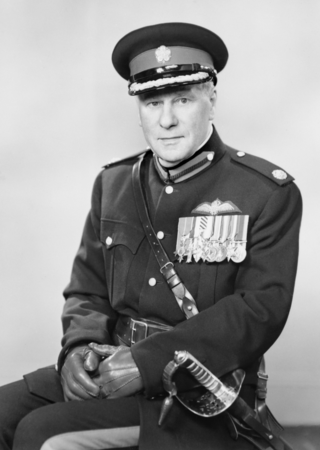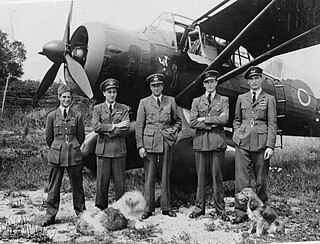Related Research Articles

The Distinguished Flying Cross (DFC) is the third-level military decoration awarded to officers, and since 1993 to other ranks, of the United Kingdom's Royal Air Force and other services, and formerly to officers of other Commonwealth countries, for "an act or acts of valour, courage or devotion to duty whilst flying in active operations against the enemy".

The Royal Flying Corps (RFC) was the air arm of the British Army before and during the First World War until it merged with the Royal Naval Air Service on 1 April 1918 to form the Royal Air Force. During the early part of the war, the RFC supported the British Army by artillery co-operation and photographic reconnaissance. This work gradually led RFC pilots into aerial battles with German pilots and later in the war included the strafing of enemy infantry and emplacements, the bombing of German military airfields and later the strategic bombing of German industrial and transport facilities.

The Distinguished Flying Cross (DFC) is a military decoration of the United States Armed Forces. The medal was established on July 2, 1926, and is currently awarded to any persons who, after April 6, 1917, distinguish themselves by single acts of heroism or extraordinary achievement while participating in aerial flight. Both heroism and extraordinary achievement are entirely distinctive, involving operations that are not routine. The medal may be awarded to friendly foreign military members in ranks equivalent to U.S. Pay Grade of O-6 and below, in actual combat in support operations.

Wing Commander Norman Macmillan was a Scottish officer of the Royal Air Force, a World War I flying ace, test pilot, and author.

Francis Warrington Gillet was an American flying ace who served in both the American and British armed forces as a pilot during World War I. With 20 credited aerial victories he was the highest scoring pilot flying the Sopwith Dolphin, and the second highest scoring American, only surpassed by Eddie Rickenbacker.
Air Vice-Marshal Edgar James Kingston-McCloughry,, born Edgar James McCloughry, was an Australian fighter pilot and flying ace of the First World War, and a senior commander in the Royal Air Force during the Second World War. He shot down 21 aircraft and military balloons during the former war, making him the 6th highest-scoring Australian ace. He was also awarded the Distinguished Service Order and the Distinguished Flying Cross and Bar as well as being mentioned in despatches.
Air Vice-Marshal Ekanayake Edward Rohan Ameresekere, was a senior officer in the Royal Ceylon Air Force. He served as the third Commander of the Royal Ceylon Air Force. He previously served he had served as a navigator in the Royal Air Force during World War II, before qualifying as a pilot in the newly formed Royal Ceylon Air Force.
Captain Duncan William Grinnell-Milne was an English First World War pilot credited with six confirmed aerial victories, a prisoner of war who escaped from German captivity, a flying ace, and an author. Initially serving with the 7th Battalion, Royal Fusiliers, he was seconded to the Royal Flying Corps before joining the Royal Air Force.
Air Commodore Edward Barnes Sismore DSO, DFC & Two Bars, AFC, AE was a British air navigator and fighter pilot during the Second World War, and a senior Royal Air Force officer in the post-war years. Sismore served as the thirteenth Commandant Royal Observer Corps between 1971 and 1973.
Flight Lieutenant James Anderson Slater was a British First World War flying ace, credited with 24 aerial victories. He served in the Royal Air Force (RAF) as an instructor after the war until killed in a flying accident.
Lieutenant Colonel Robert Leith-Macgregor MC DFC was a British Army officer and Royal Air Force pilot. He fought in the Second World War, initially as an infantry officer in the Royal Northumberland Fusiliers, before training as a pilot and transferring to the Royal Air Force. He was shot down several times and eventually became a prisoner of war. Post-war, he returned to the army, serving again with the Royal Northumberland Fusiliers in the Korean War, and later commanding a battalion of that regiment.
Arthur Rowe Spurling, was a Bermudian who served during the First World War as an infantryman and an aviator, becoming an ace credited with six aerial victories. He later served as a ferry pilot during the Second World War.
Awdry Morris Vaucour, was a First World War flying ace credited with seven aerial victories. For part of his career he flew with observer/gunner Alan Bott, who would go on to become an ace in his own right. Vaucour was killed in Italy in a "friendly fire" incident, when he was shot down by an Italian Hanriot pilot.
Flight Lieutenant David Arthur Stewart, was a British First World War flying ace credited with sixteen aerial victories. Remarkably, they were all scored while he was flying bombers instead of fighters.
Lawrence Percival Coombes was a British-Australian aeronautical engineer who served as the first Chief Superintendent of the Australian Aeronautical Research Laboratories from 1938 until 1964. He had previously worked at the Royal Aircraft Establishment from 1924, and during World War I had served as a pilot in the Royal Naval Air Service and Royal Air Force, becoming a flying ace credited with 15 aerial victories.
Sydney "Timbertoes" Carlin, was a British flying ace of the First World War, despite having previously lost a leg during the Battle of the Somme. He returned to the Royal Air Force in the Second World War, serving as an air gunner during the Battle of Britain.

John Edgcumbe Doyle was a British First World War flying ace credited with nine confirmed victories. He was shot down on 6 September 1918 and taken prisoner and his right leg was amputated. He was repatriated on 20 December 1918 and invalided out of the RAF.
Wing Commander William Ronald Read, was a highly decorated Royal Air Force (RAF) officer of the First World War and the inter-war period. A pre-war member of the Royal Flying Corps, he was one of only twelve officers to receive a second Bar to the Air Force Cross, signifying three awards of the medal.

Ian Kingston Pembroke Cross, was a British Royal Air Force officer and bomber pilot who was taken prisoner during the Second World War. Notable for his part in the 'Great Escape' from Stalag Luft III in March 1944 when he was one of the men recaptured and subsequently murdered by the Gestapo.

James Atterby McCairns, was an English pilot with the Royal Air Force. He flew the Supermarine Spitfire fighter before becoming a prisoner of war, escaping and returning to England. He returned to active service as a "special duties" pilot working with Special Operations Executive, carrying agents to and from occupied France, before returning to combat in 1945 as a successful fighter pilot. He was decorated for gallantry five times and was killed in an air crash in 1948.
References
- 1 2 3 4 5 "Second Lieutenant Lawrence Arthur Wingfield M.C., D.F.C., R.F.C. and R.A.F." sussexhistoryforum.co.uk. Retrieved 19 December 2023.
- ↑ "Guild of Air Pilots and Air Navigators of the British Empire - Graces Guide". www.gracesguide.co.uk. Retrieved 19 December 2023.
- ↑ "Archives at Cobham House" (PDF). Guild News (171): 16. October 2008.
- ↑ "Private Papers of Lieutenant L A Wingfield MC DFC". Imperial War Museums. Retrieved 19 December 2023.
This article needs additional or more specific categories .(December 2023) |